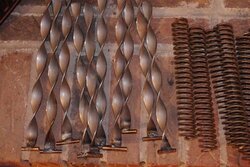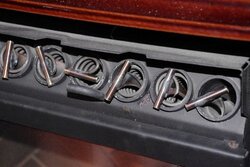A while back I had a thread that outlined my efforts and those of some of you guys in trying to wring more heat out of our Quadrafire Castiles, Sante Fe's, and 1200's. For a background on what we did and the results  > https://www.hearth.com/econtent/index.php/forums/viewthread/64123/
> https://www.hearth.com/econtent/index.php/forums/viewthread/64123/
Skidozer emailed me that he had found some of the turbulator material and offered me some pieces already cut to length with a cross piece on it to keep it from going down in the heat exchanger tubes if I would experiment with them. Of course, being the tinkerer that I am, I accepted. Today I got around to running another experiment in four parts. First of all, I removed my springs from the tubes and set my running conditions, which were a medium feed rate and high convection blower speed. The blower speed stays on high no matter what the feed rate now that I did the B-Mod modification. I have the feed rate adjusted so that the flame is just barely, on average, coming out of the burn pot. Sometimes there is very little flame and other times it may reach up to a max of about 4". I'm mainly heating a 400 sq ft family room with this one so I don't need a lot of heat.
I let the stove reach steady state and took temperature readings in the CENTER of each tube. I also used a Dwyer wind velocity meter to measure air exit speed. This second part is rather sketchy and not all that scientific but better than nothing as long as I can duplicate the instrument's position in front of each tube. In some instances with the turbulators in place, it was difficult to get a good reading so I went for the highest reading I could get. The turbulators also probably swirled the air making it more difficult to measure but the swirling is what we want to gather more heat.
Next I put just the turbulators in all 10 holes, let it get to steady state and measured again. Then I put the springs in place in tubes 2-9 (only have 8 of them) and measured. Finally I put the turbulators and springs together into the tubes. From the attached chart you can see the resulting temperatures and speeds. You can see that the springs increased the speed quite a bit probably due to some restriction as well as the buffeting/swirling they impart to the airflow. You can also see that the addition of the turbulators SIGNIFICANTLY increased the output temperature while not causing any real increase in air speed, which to me means more heat is being extracted. I am also attaching pictures of the turbulators and both the springs and turbulators installed. Enjoy! I'm enjoying the heat. By the time I was done with all the swapping, the room was at 78 degrees !
!
 > https://www.hearth.com/econtent/index.php/forums/viewthread/64123/
> https://www.hearth.com/econtent/index.php/forums/viewthread/64123/Skidozer emailed me that he had found some of the turbulator material and offered me some pieces already cut to length with a cross piece on it to keep it from going down in the heat exchanger tubes if I would experiment with them. Of course, being the tinkerer that I am, I accepted. Today I got around to running another experiment in four parts. First of all, I removed my springs from the tubes and set my running conditions, which were a medium feed rate and high convection blower speed. The blower speed stays on high no matter what the feed rate now that I did the B-Mod modification. I have the feed rate adjusted so that the flame is just barely, on average, coming out of the burn pot. Sometimes there is very little flame and other times it may reach up to a max of about 4". I'm mainly heating a 400 sq ft family room with this one so I don't need a lot of heat.
I let the stove reach steady state and took temperature readings in the CENTER of each tube. I also used a Dwyer wind velocity meter to measure air exit speed. This second part is rather sketchy and not all that scientific but better than nothing as long as I can duplicate the instrument's position in front of each tube. In some instances with the turbulators in place, it was difficult to get a good reading so I went for the highest reading I could get. The turbulators also probably swirled the air making it more difficult to measure but the swirling is what we want to gather more heat.
Next I put just the turbulators in all 10 holes, let it get to steady state and measured again. Then I put the springs in place in tubes 2-9 (only have 8 of them) and measured. Finally I put the turbulators and springs together into the tubes. From the attached chart you can see the resulting temperatures and speeds. You can see that the springs increased the speed quite a bit probably due to some restriction as well as the buffeting/swirling they impart to the airflow. You can also see that the addition of the turbulators SIGNIFICANTLY increased the output temperature while not causing any real increase in air speed, which to me means more heat is being extracted. I am also attaching pictures of the turbulators and both the springs and turbulators installed. Enjoy! I'm enjoying the heat. By the time I was done with all the swapping, the room was at 78 degrees
 !
!




 ) need 1" width tape. Getting one inch flat stock, clamping on end in a vise, and twisting the other end with pliers or a jig with a handle would also be possible.
) need 1" width tape. Getting one inch flat stock, clamping on end in a vise, and twisting the other end with pliers or a jig with a handle would also be possible.